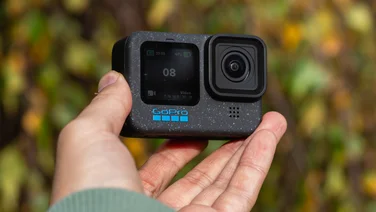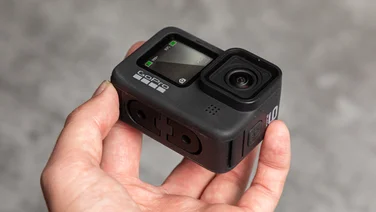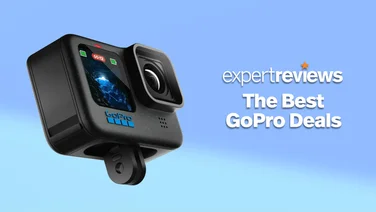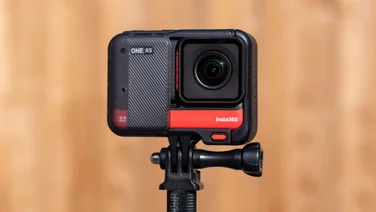To help us provide you with free impartial advice, we may earn a commission if you buy through links on our site. Learn more







- Quick-release mounting
- 360-horizon levelling
- Excellent audio quality
- Image quality can’t match a GoPro
- Mediocre image quality in low light
The DJI Osmo Action 3 has a tough battle on its hands. Its main rival, GoPro, dominates the market so completely that to make any headway it has to offer something extra, and ideally for less money.
In some ways, this new camera offers both. It has impressive-looking specifications – including a large 1/1.7in sensor – plus a clever magnetic mounting system that lets you swap the camera from one mount to another quickly as well as shoot vertical footage, and a touch-sensitive front-facing display.
And, yes, it is also significantly cheaper than its main rival. The big question is can it compete where it matters: image quality?
READ NEXT: The best action cameras to buy today
DJI Osmo Action 3 review: What do you get for the money?
Before I get to that question in detail, though, let’s address the key components of this action camera: price, features and design. On all counts, the DJI Osmo Action 3 is very much a challenger to the best that GoPro has to offer.
The standard bundle is £309 and this is cheaper than anything GoPro is offering right now with both the GoPro Hero10 Black and new Hero11 Black significantly more expensive. The former still costs £350 (when bought with a 12-month GoPro subscription) and the latter costs £400. If you’re looking for a good-quality action camera on the cheap, the DJI Osmo Action 3 is the real deal.
And it certainly looks the part. It’s robustly built, water-resistant to 16m without a case (that’s better than anything GoPro offers) and comes with a new quick-release mounting system that offers a bit more flexibility than any other I’ve come across. Instead of having prongs permanently built into the base of the camera, as GoPro’s cameras do, the bottom of the Osmo Action 3 is magnetised and the prongs come on a separate quick-release plate.

This makes it much easier to detach and reattach the camera and swap between mounts, avoiding the fiddly process of having to screw your camera to securely mount it – and unscrew it when you need to move it. Add the protective frame that comes supplied with the standard bundle and you can even mount the camera on its end, to shoot vertical footage for social media.
The camera also comes with a pair of colour screens but it one-ups the GoPro Hero11 Black again by including a touchscreen on the front. There’s also a dedicated colour-temperature sensor, which handles setting the white point in your videos automatically. The DJI even competes with GoPro on sensor size: remarkably, for the money, it has a larger sensor (1/1.7in) than the GoPro Hero11 Black (1/1.9in) and it captures video at bit rates of up to 130Mbits/sec.

DJI Osmo Action 3 review: How good is image and audio quality?
One critical area, however, in which the DJI Osmo Action 3 can’t match GoPro Hero11 Black is the range of shooting modes it offers. Sure, it can capture 4K video at up to 120fps and has full 360-degree horizon levelling, but its rival goes several steps further, offering video capture at up to 5.3K and 60fps, shooting in 10-bit colour in addition to the same 360-degree horizon levelling.
The DJI also falls behind when it comes to stills photography – it’s restricted to 12MP where the GoPro goes all the way up to 27MP – and these aren’t the only limitations.

As with most action cameras, you can’t use all of the new headline features at once. For instance, the new 360-degree horizon levelling stabilisation mode – which keeps your footage dead level no matter the direction in which the camera is pointing – is only available in resolutions up to 2.7K at up to 60fps. There is a middle-of-the-road “HorizonBalanced” mode that corrects movements up to 45 degrees left or right, and this lets you shoot in 4K at 60fps. However, even this mode restricts you to a 16:9 aspect ratio, not the full unbridled 4:3.
Despite these limitations, however, I found performance to be pretty impressive. The camera’s image stabilisation ensured footage remained smooth, even while the camera was shaking around quite violently, and the horizon levelling was effective, keeping video dead level.
In good light the camera resolved plenty of detail, too. In the video below I’ve put it side-by-side with the GoPro Hero10 Black as I haven’t yet had the chance to test out a Hero11 Black and, although the GoPro is clearly better, the DJI gets pretty close. (You’ll need to ignore the colour balance on the GoPro; I left it in Flat colour mode and had to colour grade in post.)
Where the DJI Osmo Action 3 suffers is in low light. Despite its (marginally) larger sensor, footage captured in extremely dim conditions looked much noisier and grainier than the same clip captured at the same time with the GoPro Hero10 Black. With the GoPro Hero11 Black now available, and presumably even better, the DJI Osmo Action 3 finds itself at a significant disadvantage.
READ NEXT: The best action cameras to buy today
DJI Osmo Action 3 review: What else do we like?
Still, outright image quality isn’t everything. Audio quality, especially for vloggers, is important too, and it’s here that the DJI draws level with GoPro. Recorded audio isn’t as full-bodied as on the GoPro Hero10 Black but the Osmo Action 3’s three microphones capture clear audio from both the front or the rear of the camera.
Also worth noting is that battery life is decent, too. DJI claims the camera’s Extreme battery can keep the camera shooting at up to 160 minutes in total, although that’s only at 1080p 30fps with both screens turned off. For comparison, the Hero11 Black can deliver up to 137 minutes at that resolution and frame rate, while the Hero10 Black only gives you up to 120 minutes – and you have to purchase the Enduro battery to get even that.

Of course, that lengthy battery life falls dramatically when you up the frame rate and resolution, enable stabilisation and horizon levelling. At 4K 60 with HorizonBalanced mode switched on, it recorded for 19mins 32secs before giving me an overheating warning. It doesn’t take much to improve that, however. Reducing the frame rate to 30fps saw off the overheating issues completely and the camera was able to record continuously until the battery died. That’s more than two hours than the GoPro Hero10 Black managed (around 49 minutes) with the same settings. The battery supports fast-charging, too, and will go from zero to 80% in as little as 18 minutes and zero to 100% in around 50 minutes.
Lastly, it’s also worth pointing out that the lens provides a wider field of view than any GoPro at up to 155 degrees, although this isn’t quite as useful as it sounds for vloggers, as narrowing the viewpoint will inevitably result in a loss of resolution as the camera crops in.
DJI Osmo Action 3 review: Verdict
The DJI Osmo Action 3 has plenty going for it, then. It’s a lot cheaper than the GoPro Hero11 Black, it’s more water-resistant and the mounting system is a major boon. Decent image quality, effective stabilisation and horizon levelling, good battery life and fast charging times plus a front-facing colour touchscreen contribute to what is a solid overall package.
It’s true that image quality or resolution can’t match the best that GoPro has to offer, especially now that the Hero11 Black has arrived with its 5.3K 360-degree horizon levelling. However, if you can’t quite justify spending £400 on the new GoPro Hero11 Black or the Mini (the Hero10 Black remains more expensive, too, even after having been reduced in price) then the DJI Osmo Action 3 is a solid, well-priced alternative.








